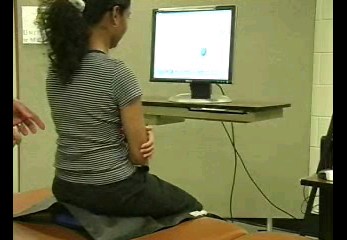Interactive Exercise Gaming System for Balance Rehabilitation Using Centre of Pressure
A flexible pressure mat (FSA pressure mapping system, Vista Medical Inc., Winnipeg, Canada) from which it acquires contact forces between body and support surface to and determines centre of pressure (COP) coordinates.
The pressure mat is flexible and can be placed on top of different compliant surfaces. In this video a blue air bladder (Swiss disk) is used as the support surface in sitting. The air pressure of the bladder (surface compliance) can be adjusted in order to grade the balance requirements as appropriate for training.
Interactive exercise gaming: the instantaneous physical COP x-y position is filtered, mapped (slaved) to the computer game sprite. Thus the computer game is controlled by motion of the COP position in a manner similar to movement of the computer mouse.
In the first video game the COP position is slaved to a basket moving horizontal left to right at bottom of screen the game is to catch apples dropping vertically from random locations.
In the second game (dart game) the COP position is slaved to a vertically moving dart-board to catch darts moving across the screen form the right edge. This is also a single axes game; COP motion is forwards-backwards to match the on-screen vertical motion of the dart board.
The third game is a Balloon-Burst game which is a 2D game and more difficult. Target balloons appear randomly on the screen and the client instructed to move the small black sprite (slaved to COP position) to intersect with the insect the balloon to burst it. This requires body movements in all directions, a combination of left-right and forwards-backwards directions.
Game parameters can be changed to modify the degree of difficulty and make it easier to score points. For example:
1. Size of the sprite (basket or dart board) can be increased to reduce precision of the movement.
2. Speed of the apple drops and dart can be adjusted from slow to fast to give more/less time to catch the game objects. Thus slow and sustained movements or fast ballistic movements are required.
3. In the balloon burst game the size of the balloons can be fully adjusted and the time period given to burst the balloon can be adjusted from 1 second to 10 seconds.
4. The physical mapping of the magnitude of COP position to move the sprite 100 pixels on computer monitor can be fully adjusted so a small COP motion (e.g., 0,5mm) can move the game sprite say one-quarter of the full screen dimension or this can be set to 2 cm appropriate.
5. The COP position signal can be filtered at different levels to reduce jerky movements and unsteadiness.
REFERENCES


